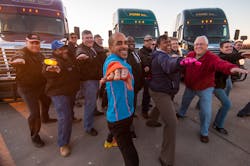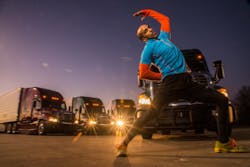For the last three years, Siphiwe Baleka has been gaining recognition with his Fitness Trucking program, serving clients including the company he once drove for, Prime, Inc. And he says the schedules that truck drivers keep and the nature of the job can make them gain weight easily.
"For most drivers, the reason why they're overweight or obese has a lot to do with their metabolism, which is related to their sleep cycles, circadian rhythms, accumulated sleep debt and stress," Baleka contends.
As commercial drivers make pickups and deliveries and keep with hours of service requirements, those rhythms and sleep cycles can get out of synch and it can slow down a driver's metabolism — and pounds can pack on quickly. A truck driver's routine often won't look anything like your typical 9-5 job where people are generally in the same place, and it can be more difficult for drivers to get into and keep with a workout schedule.
"Truckers are living in a box," Baleka says. "They don't have access to a kitchen; they have food storage issues; they're not able to get to the local farmers market every weekend. They have this unique environment and unique conditions."
Also, "drivers don't have a lot of time; they can't go to the gym for an hour," he tells Fleet Owner. "What I've found is that in order to maximize weight loss for truck drivers, it's about exercising at high heart rates and high intensity.
"The strategy that's worked is 15 minutes a day, and that 15 minutes has got to be high-intensity in order to access your fat-burning system and get the metabolic effect" to lose weight, he continues.
Describing the program online, Baleka calls it "The 15/4 Movement" — within 15 minutes of exercise, four minutes are vigorous exercise. If you don't have time for all 15 minutes, "you can still move for four minutes with maximum intensity and burn as much fat as one hour of moderate activity like jogging or the elliptical machine," he writes.
Further, it's not all about cutting calories you eat, according to Baleka. He says the majority of drivers coming into his 13-week Fitness Trucking program actually have a calorie deficit, meaning they're burning more calories than they're taking in.
"If it were all about calories in, calories out, they shouldn't be overweight and in my program to begin with," Baleka quips.
In his program, drivers log everything they eat and monitor their nutrition for the 91-day duration, and their diet is revamped to reduce carbohydrate intake. The average change in overall calorie intake by the end of the program, Baleka says, is only about 70 calories, "which is like half a cookie — they're not losing weight because they're manipulating their calories."
The average weight loss for people who take the Fitness Trucking program is 19.3 lbs., he notes, or about 7% of body weight.
"It's not about calories, it's about spiking your metabolism through high-intensity exercise and reducing your carbohydrates," he emphasizes. "You can eat the same amount of calories and reduce your carbs and lose a tremendous amount of weight."
Problems with fitness wearables
Baleka notes that he has tested and used a number of fitness-tracking wearable technologies — many of them watch-type tech worn on the wrist — and says there's a problem with the direction the wearables industry has been taking by favoring optical heart rate technology.
According to Apple's website, for example, the Apple Watch uses LED lights and photodiodes to detect blood flow in a person's wrist and take his or her pulse. While optical-sensing tech may work well for some types of exercise, other athletes complain it's not very accurate for them.
"That's a real problem with this industry," Baleka says, adding that the optical heart rate monitoring and overall fitness metrics that many wearables employ don't cut it for truckers and his program.
"You could walk a million extra steps, for example, and never have an effect on your metabolism," he contends. "It's not accessing your fat-burning system or creating a high enough demand for energy to spike your metabolism.
"So all these calorie trackers and how many calories you burn and all of that is missing the point," he says.
Regarding the common optical heart rate monitors, Baleka says the products that use them "are mostly made for people doing steady-state cardio — maybe they're on an elliptical [machine] or exercise bike.
"But as soon as you start to do body exercises like in my program where you're going from the ground to a different position to a different position and your wrist position is changing, the optical sensors fail," he continues.
So what works well? Baleka notes that in his experience, some wearables like the BodyMedia FIT LINK armband do, but the company was acquired and the armband is no longer being manufactured.
On-demand heart rate monitors, such as ones "where you put your finger on it and hold a button for 3 or 4 seconds and it gives you your heart rate reading, those are the most valuable for my program, but everyone's moving away from manufacturing them," Baleka tells Fleet Owner.
Even if he's disappointed with many popular fitness wearables, he says he's hopeful his program will help many truckers and, for that matter, others who try his workouts. "This is ground zero in the war against adult obesity," he says. "Trucking is the occupation with the highest obesity rate and the highest rate of metabolic syndrome.
"If we can get it right with truck drivers and the trucking industry — which is what my mission is — we can set an example for the rest of America," Baleka contends.
About the Author
Aaron Marsh
Aaron Marsh is a former senior editor of FleetOwner, who wrote for the publication from 2015 to 2019.



